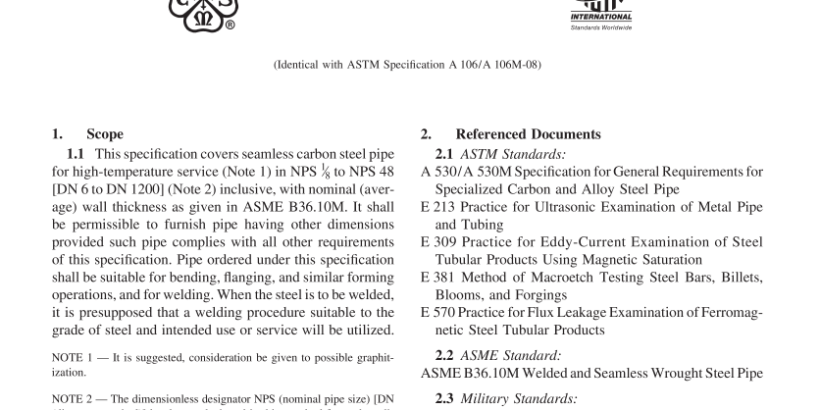ASME SA-106 2019 pdf free download.SPECIFICATION FOR SEAMLESS CARBON STEEL PIPE FOR HIGH-TEMPERATURE SERVICE
4. Process
4.1 The steel shall be killed steel, with the primary melting process being open-hearth, basic-oxygen, or elec- tric-furnace, possibly combined with separate degassing or refining. If secondary melting, using electroslag remelting or vacuum-arc remelting is subsequently employed, the heat shall be defined as all of the ingots remelted from a single primary heat.
4.2 Steel cast in ingots or strand cast is permissible. When steels ofdifferentgrades are sequentially strand cast, identification ofthe resultanttransition material is required. The producer shall remove the transition material by any established procedure that positively separates the grades.
4.3 For pipe NPS 1 1 ⁄ 2 [DN 40] and under, it shall be permissible to furnish hot finished or cold drawn.
4.4 Unless otherwise specified, pipe NPS 2 [DN 50] and over shall be furnished hot finished. When agreed upon between the manufacturer and the purchaser, it is permissible to furnish cold-drawn pipe.
5. Heat Treatment
5.1 Hot-finished pipe need not be heat treated. Cold- drawn pipe shall be heat treated after the final cold draw pass at a temperature of 1200°F (650°C) or higher.
6. General Requirements
6.1 Material furnished to this specification shall con- form to the applicable requirements of the current edition ofSpecification A 530/A 530M unless otherwise provided herein.
7. Chemical Composition
7.1 The steel shall conform to the requirements as to chemical composition prescribed in Table 1.
8. Heat Analysis
8.1 An analysis of each heat of steel shall be made by the steel manufacturer to determine the percentages of the elements specified in Section 7. If the secondary melting processes of 5.1 are employed, the heat analysis shall be obtained from one remelted ingot or the product of one remelted ingot ofeach primary melt. The chemical compo- sition thus determined, or that determined from a product analysis made by the manufacturer, if the latter has not manufactured the steel, shall be reported to the purchaser or the purchaser’s representative, and shall conform to the requirements specified in Section 7.
9. Product Analysis
9.1 At the request of the purchaser, analyses of two pipes from each lot (see 20.1) shall be made by the manu- facturerfromthe finishedpipe. Theresults oftheseanalyses shall be reported to the purchaser or the purchaser’s repre- sentative and shall conform to the requirements specified in Section 7.
9.2 If the analysis of one of the tests specified in 9.1 does notconformto the requirements specifiedinSection7, analyses shall be made on additional pipes of double the original number from the same lot, each of which shall conform to requirements specified. 10. Tensile Requirements
10.1 The material shall conform to the requirements as to tensile properties given in Table 2. 11. Bending Requirements
11.1 For pipe NPS 2 [DN 50] and under, a sufficient length of pipe shall stand being bent cold through 90° around a cylindrical mandrel, the diameter of which is twelve times the outside diameter (as shown in ASME B36.10M) of the pipe, without developing cracks. When ordered for close coiling, the pipe shall stand being bent cold through 180° around a cylindrical mandrel, the diame- ter of which is eight times the outside diameter (as shown in ASME B36.10M) of the pipe, without failure.
11.2 For pipe whose diameter exceeds 25 in. [635 mm] and whose diameter to wall thickness ratio, where the diameter to wall thickness ratio is the specified outside diameter divided by the nominal wall thickness, is 7.0 or less, the bend test shall be conducted. The bend test speci- mens shall be bent at room temperature through 180° with the inside diameter ofthe bend being 1 in. [25 mm] without cracking on the outside portion of the bent portion. Example: For 28 in. [711 mm] diameter 5.000 in. [127 mm] thick pipe the diameter to wall thickness ratio p 28/5 p 5.6 [711/127 p 5.6].
12. Flattening Tests
12.1 Although testing is not required, pipe shall be capable ofmeeting the flattening test requirements of Sup- plementary Requirement S3, if tested.ASME SA-106 pdf download.ASME SA-106-2019 pdf free download
